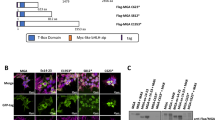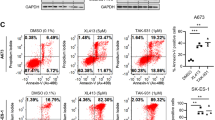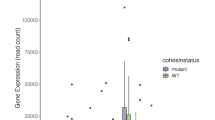Abstract
NUP98 gene rearrangements occur in acute myeloid leukemia and result in the expression of fusion proteins. One of the most frequent is NUP98–DDX10 that fuses a portion of NUP98 to a portion of DDX10, a putative DEAD-box RNA helicase. Here, we show that NUP98–DDX10 dramatically increases proliferation and self-renewal of primary human CD34+ cells, and disrupts their erythroid and myeloid differentiation. It localizes to their nuclei and extensively deregulates gene expression. Comparison to another leukemogenic NUP98 fusion, NUP98–HOXA9, reveals a number of genes deregulated by both oncoproteins, including HOX genes, COX-2, MYCN, ANGPT1, REN, HEY1, SOX4 and others. These genes may account for the similar leukemogenic properties of NUP98 fusion oncogenes. The YIHRAGRTAR sequence in the DDX10 portion of NUP98–DDX10 represents a major motif shared by DEAD-box RNA helicases that is required for ATP binding, RNA-binding and helicase functions. Mutating this motif diminished the in vitro transforming ability of NUP98–DDX10, indicating that it has a role in leukemogenesis. These data show for the first time the in vitro transforming ability of NUP98–DDX10 and show that it is partially dependent on one of the consensus helicase motifs of DDX10. They also point to common pathways that may underlie leukemogenesis by different NUP98 fusions.
This is a preview of subscription content, access via your institution
Access options
Subscribe to this journal
Receive 12 print issues and online access
$259.00 per year
only $21.58 per issue
Buy this article
- Purchase on Springer Link
- Instant access to full article PDF
Prices may be subject to local taxes which are calculated during checkout






Similar content being viewed by others
References
Romana SP, Radford-Weiss I, Ben Abdelali R, Schluth C, Petit A, Dastugue N et al. NUP98 rearrangements in hematopoietic malignancies: a study of the Groupe Francophone de Cytogenetique Hematologique. Leukemia 2006; 20: 696–706.
Slape C, Aplan PD . The role of NUP98 gene fusions in hematologic malignancy. Leuk Lymphoma 2004; 45: 1341–1350.
Bai XT, Gu BW, Yin T, Niu C, Xi XD, Zhang J et al. Trans-repressive effect of NUP98-PMX1 on PMX1-regulated c-FOS gene through recruitment of histone deacetylase 1 by FG repeats. Cancer Res 2006; 66: 4584–4590.
Bei L, Lu Y, Eklund EA . HOXA9 activates transcription of the gene encoding gp91Phox during myeloid differentiation. J Biol Chem 2005; 280: 12359–12370.
Ghannam G, Takeda A, Camarata T, Moore MA, Viale A, Yaseen NR . The oncogene Nup98-HOXA9 induces gene transcription in myeloid cells. J Biol Chem 2004; 279: 866–875.
Kasper LH, Brindle PK, Schnabel CA, Pritchard CE, Cleary ML, van Deursen JM . CREB binding protein interacts with nucleoporin-specific FG repeats that activate transcription and mediate NUP98-HOXA9 oncogenicity. Mol Cell Biol 1999; 19: 764–776.
Arai Y, Hosoda F, Kobayashi H, Arai K, Hayashi Y, Kamada N et al. The inv(11)(p15q22) chromosome translocation of de novo and therapy- related myeloid malignancies results in fusion of the nucleoporin gene, NUP98, with the putative RNA helicase gene, DDX10. Blood 1997; 89: 3936–3944.
Savitsky K, Ziv Y, Bar-Shira A, Gilad S, Tagle DA, Smith S et al. A human gene (DDX10) encoding a putative DEAD-box RNA helicase at 11q22-q23. Genomics 1996; 33: 199–206.
Yassin ER, Sarma NJ, Abdul-Nabi AM, Dombrowski J, Han Y, Takeda A et al. Dissection of the transformation of primary human hematopoietic cells by the oncogene NUP98-HOXA9. PLoS One 2009; 4: e6719.
Takeda A, Goolsby C, Yaseen NR . NUP98-HOXA9 induces long-term proliferation and blocks differentiation of primary human CD34+ hematopoietic cells. Cancer Res 2006; 66: 6628–6637.
Powers MA, Macaulay C, Masiarz FR, Forbes DJ . Reconstituted nuclei depleted of a vertebrate GLFG nuclear pore protein, p97, import but are defective in nuclear growth and replication. J Cell Biol 1995; 128: 721–736.
Fontoura BM, Dales S, Blobel G, Zhong H . The nucleoporin Nup98 associates with the intranuclear filamentous protein network of TPR. Proc Natl Acad Sci USA 2001; 98: 3208–3213.
Schwartz TU . Modularity within the architecture of the nuclear pore complex. Curr Opin Struct Biol 2005; 15: 221–226.
Kos M, Tollervey D . The Putative RNA Helicase Dbp4p Is Required for Release of the U14 snoRNA from Preribosomes in Saccharomyces cerevisiae. Mol Cell 2005; 20: 53–64.
Liang WQ, Clark JA, Fournier MJ . The rRNA-processing function of the yeast U14 small nucleolar RNA can be rescued by a conserved RNA helicase-like protein. Mol Cell Biol 1997; 17: 4124–4132.
Andersen JS, Lam YW, Leung AK, Ong SE, Lyon CE, Lamond AI et al. Nucleolar proteome dynamics. Nature 2005; 433: 77–83.
Scherl A, Coute Y, Deon C, Calle A, Kindbeiter K, Sanchez JC et al. Functional proteomic analysis of human nucleolus. Mol Biol Cell 2002; 13: 4100–4109.
Radu A, Moore MS, Blobel G . The peptide repeat domain of nucleoporin Nup98 functions as a docking site in transport across the nuclear pore complex. Cell 1995; 81: 215–222.
Moore MA, Chung KY, Plasilova M, Schuringa JJ, Shieh JH, Zhou P et al. NUP98 dysregulation in myeloid leukemogenesis. Ann N Y Acad Sci 2007; 1106: 114–142.
Jankovic D, Gorello P, Liu T, Ehret S, La Starza R, Desjobert C et al. Leukemogenic mechanisms and targets of a NUP98/HHEX fusion in acute myeloid leukemia. Blood 2008; 111: 5672–5682.
Gurevich RM, Aplan PD, Humphries RK . NUP98-topoisomerase I acute myeloid leukemia-associated fusion gene has potent leukemogenic activities independent of an engineered catalytic site mutation. Blood 2004; 104: 1127–1136.
Sutherland HJ, Lansdorp PM, Henkelman DH, Eaves AC, Eaves CJ . Functional characterization of individual human hematopoietic stem cells cultured at limiting dilution on supportive marrow stromal layers. Proc Natl Acad Sci USA 1990; 87: 3584–3588.
Argiropoulos B, Humphries RK . Hox genes in hematopoiesis and leukemogenesis. Oncogene 2007; 26: 6766–6776.
Sitwala KV, Dandekar MN, Hess JL . HOX proteins and leukemia. Int J Clin Exp Pathol 2008; 1: 461–474.
Pineault N, Helgason CD, Lawrence HJ, Humphries RK . Differential expression of Hox, Meis1, and Pbx1 genes in primitive cells throughout murine hematopoietic ontogeny. Exp Hematol 2002; 30: 49–57.
Kroon E, Thorsteinsdottir U, Mayotte N, Nakamura T, Sauvageau G . NUP98-HOXA9 expression in hemopoietic stem cells induces chronic and acute myeloid leukemias in mice. EMBO J 2001; 20: 350–361.
Kawagoe H, Humphries RK, Blair A, Sutherland HJ, Hogge DE . Expression of HOX genes, HOX cofactors, and MLL in phenotypically and functionally defined subpopulations of leukemic and normal human hematopoietic cells. Leukemia 1999; 13: 687–698.
Lawrence HJ, Rozenfeld S, Cruz C, Matsukuma K, Kwong A, Komuves L et al. Frequent co-expression of the HOXA9 and MEIS1 homeobox genes in human myeloid leukemias. Leukemia 1999; 13: 1993–1999.
Afonja O, Smith Jr JE, Cheng DM, Goldenberg AS, Amorosi E, Shimamoto T et al. MEIS1 and HOXA7 genes in human acute myeloid leukemia. Leuk Res 2000; 24: 849–855.
Drabkin HA, Parsy C, Ferguson K, Guilhot F, Lacotte L, Roy L et al. Quantitative HOX expression in chromosomally defined subsets of acute myelogenous leukemia. Leukemia 2002; 16: 186–195.
Bullinger L, Dohner K, Bair E, Frohling S, Schlenk RF, Tibshirani R et al. Use of gene-expression profiling to identify prognostic subclasses in adult acute myeloid leukemia. N Engl J Med 2004; 350: 1605–1616.
Palmqvist L, Pineault N, Wasslavik C, Humphries RK . Candidate genes for expansion and transformation of hematopoietic stem cells by NUP98-HOX fusion genes. PLoS ONE 2007; 2: e768.
Pineault N, Buske C, Feuring-Buske M, Abramovich C, Rosten P, Hogge DE et al. Induction of acute myeloid leukemia in mice by the human leukemia-specific fusion gene NUP98-HOXD13 in concert with Meis1. Blood 2003; 101: 4529–4538.
Hirose K, Abramovich C, Argiropoulos B, Humphries RK . Leukemogenic properties of NUP98-PMX1 are linked to NUP98 and homeodomain sequence functions but not to binding properties of PMX1 to serum response factor. Oncogene 2008; 27: 6056–6067.
Wang GG, Cai L, Pasillas MP, Kamps MP . NUP98-NSD1 links H3K36 methylation to Hox-A gene activation and leukaemogenesis. Nat Cell Biol 2007; 9: 804–812.
Tokura Y, Shikami M, Miwa H, Watarai M, Sugamura K, Wakabayashi M et al. Augmented expression of P-gp/multi-drug resistance gene by all-trans retinoic acid in monocytic leukemic cells. Leuk Res 2002; 26: 29–36.
Yuan W, Payton JE, Holt MS, Link DC, Watson MA, DiPersio JF et al. Commonly dysregulated genes in murine APL cells. Blood 2007; 109: 961–970.
Fang J, Menon M, Kapelle W, Bogacheva O, Bogachev O, Houde E et al. EPO modulation of cell-cycle regulatory genes, and cell division, in primary bone marrow erythroblasts. Blood 2007; 110: 2361–2370.
Du Y, Spence SE, Jenkins NA, Copeland NG . Cooperating cancer-gene identification through oncogenic-retrovirus-induced insertional mutagenesis. Blood 2005; 106: 2498–2505.
Boyd KE, Xiao YY, Fan K, Poholek A, Copeland NG, Jenkins NA et al. Sox4 cooperates with Evi1 in AKXD-23 myeloid tumors via transactivation of proviral LTR. Blood 2005; 107: 733–741.
Tonks A, Pearn L, Musson M, Gilkes A, Mills KI, Burnett AK et al. Transcriptional dysregulation mediated by RUNX1-RUNX1T1 in normal human progenitor cells and in acute myeloid leukaemia. Leukemia 2007; 21: 2495–2505.
Pession A, Tonelli R . The MYCN oncogene as a specific and selective drug target for peripheral and central nervous system tumors. Curr Cancer Drug Targets 2005; 5: 273–283.
Mao X, Onadim Z, Price EA, Child F, Lillington DM, Russell-Jones R et al. Genomic alterations in blastic natural killer/extranodal natural killer-like T cell lymphoma with cutaneous involvement. J Invest Dermatol 2003; 121: 618–627.
Schwaenen C, Nessling M, Wessendorf S, Salvi T, Wrobel G, Radlwimmer B et al. Automated array-based genomic profiling in chronic lymphocytic leukemia: development of a clinical tool and discovery of recurrent genomic alterations. Proc Natl Acad Sci USA 2004; 101: 1039–1044.
Kawagoe H, Kandilci A, Kranenburg TA, Grosveld GC . Overexpression of N-Myc rapidly causes acute myeloid leukemia in mice. Cancer Res 2007; 67: 10677–10685.
Iso T, Kedes L, Hamamori Y . HES and HERP families: multiple effectors of the Notch signaling pathway. J Cell Physiol 2003; 194: 237–255.
Nefedova Y, Gabrilovich D . Mechanisms and clinical prospects of Notch inhibitors in the therapy of hematological malignancies. Drug Resist Updat 2008; 11: 210–218.
Henning K, Schroeder T, Schwanbeck R, Rieber N, Bresnick EH, Just U . mNotch1 signaling and erythropoietin cooperate in erythroid differentiation of multipotent progenitor cells and upregulate beta-globin. Exp Hematol 2007; 35: 1321–1332.
Elagib KE, Xiao M, Hussaini IM, Delehanty LL, Palmer LA, Racke FK et al. Jun blockade of erythropoiesis: role for repression of GATA-1 by HERP2. Mol Cell Biol 2004; 24: 7779–7794.
Harris RE . Cyclooxygenase-2 (cox-2) and the inflammogenesis of cancer. Subcell Biochem 2007; 42: 93–126.
Bernard MP, Bancos S, Sime PJ, Phipps RP . Targeting cyclooxygenase-2 in hematological malignancies: rationale and promise. Curr Pharm Des 2008; 14: 2051–2060.
Robak P, Smolewski P, Robak T . The role of non-steroidal anti-inflammatory drugs in the risk of development and treatment of hematologic malignancies. Leuk Lymphoma 2008; 49: 1452–1462.
Pogoda JM, Katz J, McKean-Cowdin R, Nichols PW, Ross RK, Preston-Martin S . Prescription drug use and risk of acute myeloid leukemia by French–American–British subtype: results from a Los Angeles County case–control study. Int J Cancer 2005; 114: 634–638.
Dzau VJ . Circulating versus local renin-angiotensin system in cardiovascular homeostasis. Circulation 1988; 77 (Part 2): I4–13.
Haznedaroglu IC, Ozturk MA . Towards the understanding of the local hematopoietic bone marrow renin-angiotensin system. Int J Biochem Cell Biol 2003; 35: 867–880.
Mrug M, Stopka T, Julian BA, Prchal JF, Prchal JT . Angiotensin II stimulates proliferation of normal early erythroid progenitors. J Clin Invest 1997; 100: 2310–2314.
Rodgers KE, Xiong S, Steer R, diZerega GS . Effect of angiotensin II on hematopoietic progenitor cell proliferation. Stem Cells 2000; 18: 287–294.
Wulf GG, Jahns-Streubel G, Nobiling R, Strutz F, Hemmerlein B, Hiddemann W et al. Renin in acute myeloid leukaemia blasts. Br J Haematol 1998; 100: 335–337.
Inigo Sde L, Casares MT, Jorge CE, Leiza SM, Santana GS, Bravo de Laguna SJ et al. Relevance of renin expression by real-time PCR in acute myeloid leukemia. Leuk Lymphoma 2006; 47: 409–416.
Teresa Gomez Casares M, de la Iglesia S, Perera M, Lemes A, Campo C, Gonzalez San Miguel JD et al. Renin expression in hematological malignancies and its role in the regulation of hematopoiesis. Leuk Lymphoma 2002; 43: 2377–2381.
Beyazit Y, Aksu S, Haznedaroglu IC, Kekilli M, Misirlioglu M, Tuncer S et al. Overexpression of the local bone marrow renin-angiotensin system in acute myeloid leukemia. J Natl Med Assoc 2007; 99: 57–63.
De la Iglesia Inigo S, Lopez-Jorge CE, Gomez-Casares MT, Lemes Castellano A, Martin Cabrera P, Lopez Brito J et al. Induction of apoptosis in leukemic cell lines treated with captopril, trandolapril and losartan: a new role in the treatment of leukaemia for these agents. Leuk Res 2009; 33: 810–816.
Hatfield KJ, Hovland R, Oyan AM, Kalland KH, Ryningen A, Gjertsen BT et al. Release of angiopoietin-1 by primary human acute myelogenous leukemia cells is associated with mutations of nucleophosmin, increased by bone marrow stromal cells and possibly antagonized by high systemic angiopoietin-2 levels. Leukemia 2008; 22: 287–293.
Hatfield K, Oyan AM, Ersvaer E, Kalland KH, Lassalle P, Gjertsen BT et al. Primary human acute myeloid leukaemia cells increase the proliferation of microvascular endothelial cells through the release of soluble mediators. Br J Haematol 2009; 144: 53–68.
Albitar M . Angiogenesis in acute myeloid leukemia and myelodysplastic syndrome. Acta Haematol 2001; 106: 170–176.
Muller A, Lange K, Gaiser T, Hofmann M, Bartels H, Feller AC et al. Expression of angiopoietin-1 and its receptor TEK in hematopoietic cells from patients with myeloid leukemia. Leuk Res 2002; 26: 163–168.
Liebermann DA, Hoffman B . Myeloid differentiation (MyD) primary response genes in hematopoiesis. Blood Cells Mol Dis 2003; 31: 213–228.
Donato JL, Ko J, Kutok JL, Cheng T, Shirakawa T, Mao XQ et al. Human HTm4 is a hematopoietic cell cycle regulator. J Clin Invest 2002; 109: 51–58.
Dunne J, Cullmann C, Ritter M, Soria NM, Drescher B, Debernardi S et al. siRNA-mediated AML1/MTG8 depletion affects differentiation and proliferation-associated gene expression in t(8;21)-positive cell lines and primary AML blasts. Oncogene 2006; 25: 6067–6078.
Endersby R, Majewski IJ, Winteringham L, Beaumont JG, Samuels A, Scaife R et al. Hls5 regulated erythroid differentiation by modulating GATA-1 activity. Blood 2008; 111: 1946–1950.
Kimura F, Suzu S, Nakamura Y, Nakata Y, Yamada M, Kuwada N et al. Cloning and characterization of a novel RING-B-box-coiled-coil protein with apoptotic function. J Biol Chem 2003; 278: 25046–25054.
Lalonde JP, Lim R, Ingley E, Tilbrook PA, Thompson MJ, McCulloch R et al. HLS5, a novel RBCC (ring finger, B box, coiled-coil) family member isolated from a hemopoietic lineage switch, is a candidate tumor suppressor. J Biol Chem 2004; 279: 8181–8189.
Nakamura T, Yamazaki Y, Hatano Y, Miura I . NUP98 is fused to PMX1 homeobox gene in human acute myelogenous leukemia with chromosome translocation t(1;11)(q23;p15). Blood 1999; 94: 741–747.
Fuller-Pace FV . DExD/H box RNA helicases: multifunctional proteins with important roles in transcriptional regulation. Nucleic Acids Res 2006; 34: 4206–4215.
Fuller-Pace FV, Ali S . The DEAD box RNA helicases p68 (Ddx5) and p72 (Ddx17): novel transcriptional co-regulators. Biochem Soc Trans 2008; 36 (Part 4): 609–612.
Ahuja HG, Felix CA, Aplan PD . Potential role for DNA topoisomerase II poisons in the generation of t(11;20)(p15;q11) translocations. Genes Chromosomes Cancer 2000; 29: 96–105.
Morerio C, Acquila M, Rapella A, Tassano E, Rosanda C, Panarello C . Inversion (11)(p15q22) with NUP98-DDX10 fusion gene in pediatric acute myeloid leukemia. Cancer Genet Cytogenet 2006; 171: 122–125.
Caruthers JM, Johnson ER, McKay DB . Crystal structure of yeast initiation factor 4A, a DEAD-box RNA helicase. Proc Natl Acad Sci USA 2000; 97: 13080–13085.
Sengoku T, Nureki O, Nakamura A, Kobayashi S, Yokoyama S . Structural basis for RNA unwinding by the DEAD-box protein Drosophila Vasa. Cell 2006; 125: 287–300.
Cheng Z, Coller J, Parker R, Song H . Crystal structure and functional analysis of DEAD-box protein Dhh1p. RNA 2005; 11: 1258–1270.
Story RM, Li H, Abelson JN . Crystal structure of a DEAD box protein from the hyperthermophile Methanococcus jannaschii. Proc Natl Acad Sci USA 2001; 98: 1465–1470.
Pause A, Methot N, Sonenberg N . The HRIGRXXR region of the DEAD box RNA helicase eukaryotic translation initiation factor 4A is required for RNA binding and ATP hydrolysis. Mol Cell Biol 1993; 13: 6789–6798.
Watanabe M, Yanagisawa J, Kitagawa H, Takeyama K, Ogawa S, Arao Y et al. A subfamily of RNA-binding DEAD-box proteins acts as an estrogen receptor alpha coactivator through the N-terminal activation domain (AF-1) with an RNA coactivator, SRA. EMBO J 2001; 20: 1341–1352.
Acknowledgements
We thank the Alvin J. Siteman Cancer Center at Washington University School of Medicine and Barnes-Jewish Hospital in St Louis, MO, for the use of the High Speed Cell Sorter Core, which provided flow cytometry analysis and sorting services and for the use of the Multiplexed Gene Analysis Core, which provided Affymetrix GeneChip microarray services. This work was supported by National Institutes of Health Grants R01 HL082549 and K02 HL084179 (NRY), and by T32 CA009547 (AMA). The Siteman Cancer Center is supported in part by an NCI Cancer Center Support Grant no. P30 CA91842.
Author information
Authors and Affiliations
Corresponding author
Ethics declarations
Competing interests
The authors declare no conflict of interest.
Additional information
Supplementary Information accompanies the paper on the Leukemia website
Supplementary information
Rights and permissions
About this article
Cite this article
Yassin, E., Abdul-Nabi, A., Takeda, A. et al. Effects of the NUP98–DDX10 oncogene on primary human CD34+ cells: role of a conserved helicase motif. Leukemia 24, 1001–1011 (2010). https://doi.org/10.1038/leu.2010.42
Received:
Revised:
Accepted:
Published:
Issue Date:
DOI: https://doi.org/10.1038/leu.2010.42
Keywords
This article is cited by
-
DDX10 promotes the proliferation and metastasis of colorectal cancer cells via splicing RPL35
Cancer Cell International (2022)
-
Biomolecular condensation of NUP98 fusion proteins drives leukemogenic gene expression
Nature Structural & Molecular Biology (2021)
-
Seeking commonalities in fusion proteins of NUP98
Nature Structural & Molecular Biology (2021)
-
The DEAD-box protein family of RNA helicases: sentinels for a myriad of cellular functions with emerging roles in tumorigenesis
International Journal of Clinical Oncology (2021)
-
A structured population model of clonal selection in acute leukemias with multiple maturation stages
Journal of Mathematical Biology (2019)



